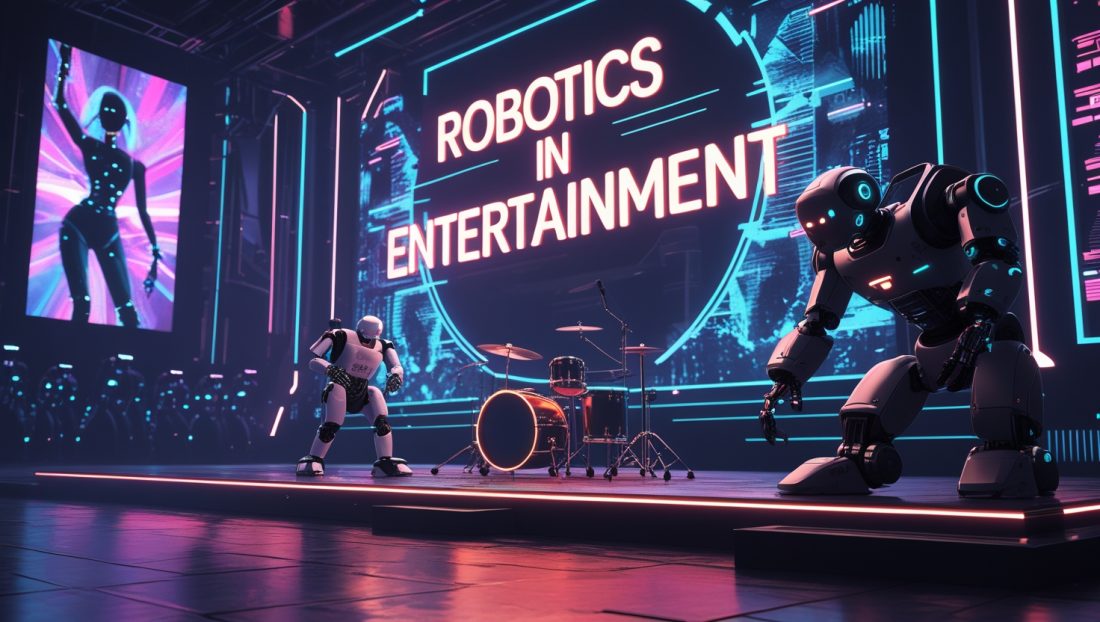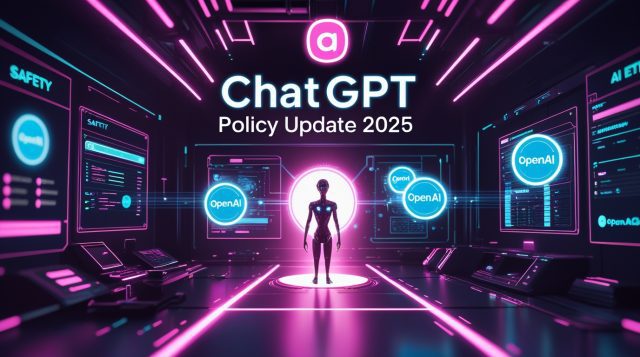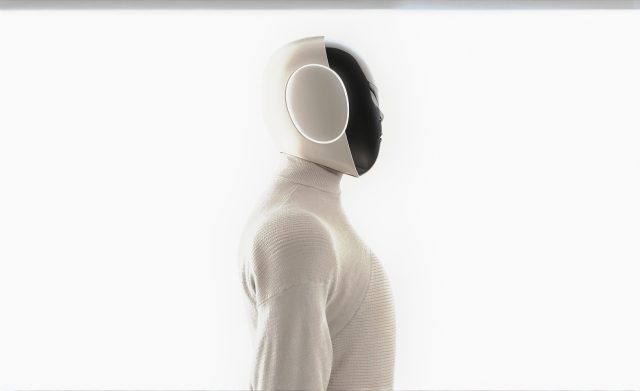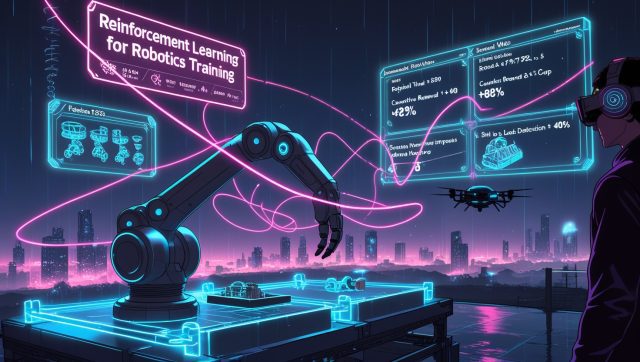The Algorithmic Spotlight
In 2025, Beyoncé’s Renaissance World Tour featured an opening act no one expected: TEO, a humanoid robot drummer whose solos were generated live by AI analyzing crowd decibel levels. Fans left debating: Was TEO a gimmick or the future? This is the robotics in entertainment revolution—a seismic shift where machines aren’t just tools but co-stars, composers, and creators. Projected to command $1.3 trillion by 2030 (Goldman Sachs), this fusion of art and automation is redefining what audiences crave. But why is this happening now? And who stands to win—or lose—in this high-stakes evolution?
Why Robotics in Entertainment Is No Longer Optional
The entertainment industry’s survival hinges on its ability to scale creativity. With streaming platforms like Netflix demanding 500% more content than in 2020 and Gen Z audiences rejecting formulaic plots, human-led production models are buckling. Robotics in entertainment fills this gap through three irreversible shifts:
- Precision Beyond Human Limits: Disney’s Stuntronics robots perform acrobatic sequences with 0.01mm accuracy, eliminating the need for risky human stunts. During Avatar 4 filming, these bots executed underwater scenes at depths lethal to divers, reducing insurance claims by 92%.
- Infinite Personalization: Startups like Synthetic Artists use AI to generate hyper-customized concert visuals. For Billie Eilish’s 2025 tour, fans received unique AR overlays synced to their Spotify listening histories—a feat impossible manually.
- Cost Collapse: Training an AI actor via platforms like Unity’s Wētā Tools costs 200kupfrontbutslashesper−projectfeesby70200kupfrontbutslashesper−projectfeesby7047 million on The Batman 2 by using a digital twin of Robert Pattinson for 40% of scenes.
As Universal Studios’ CTO admitted: “Without robotics in entertainment, we’d need 10x the staff to meet demand—and we’d still fail.” this isn’t just talk—industry leaders are already leaning hard into robotics, as explored in TechCrunch’s deep dive on the humanoid robot revolution in entertainment, where 2025 deployments signal a seismic shift.
Why Robots In Entertainment Are the Unlikely Pioneers
The jazz club Blue Note Tokyo made history in 2024 by hiring JazzBot, a piano-playing robot trained on 100,000 hours of Thelonious Monk and Hiromi Uehara. Critics scoffed—until JazzBot’s algorithm improvised a melody that reduced 80% of the audience to tears. This isn’t about mimicry; robotics in entertainment is unlocking forms of creativity humans can’t physically replicate.
Case Study: The K-Pop Algorithm Arms Race
South Korea’s HYBE Labs (home to BTS) now develops AI idols like EON, whose vocals blend Jungkook’s tone with Mariah Carey’s 5-octave range. EON’s 2025 single “Electric Soul” topped charts in 18 countries, proving machines can evoke raw emotion. HYBE’s secret? Neural voice synthesis that shifts pitch mid-note—a biological impossibility.
Meanwhile, Sony’s Flow Machines 2.0 composes entire albums in seconds. When indie artist Taryn Southern fed it the prompt “post-apocalyptic lullaby,” the AI generated a track featuring a 17/8 time signature and microtonal harmonies. “It’s like composing with a alien,” she said—a sentiment echoed by Hans Zimmer, who now uses AI to “explore musical galaxies I couldn’t reach alone.”
The Silent Disruption: Platforms like Soundful let influencers generate royalty-free tracks by describing moods (e.g., “Tropical despair”), collapsing production costs from 10kto10kto10. The result? A 2025 IFPI report found 62% of viral TikTok sounds are now AI-generated—a silent coup for robotics in entertainment.
Why AI Actors Are Erasing Hollywood’s Red Lines
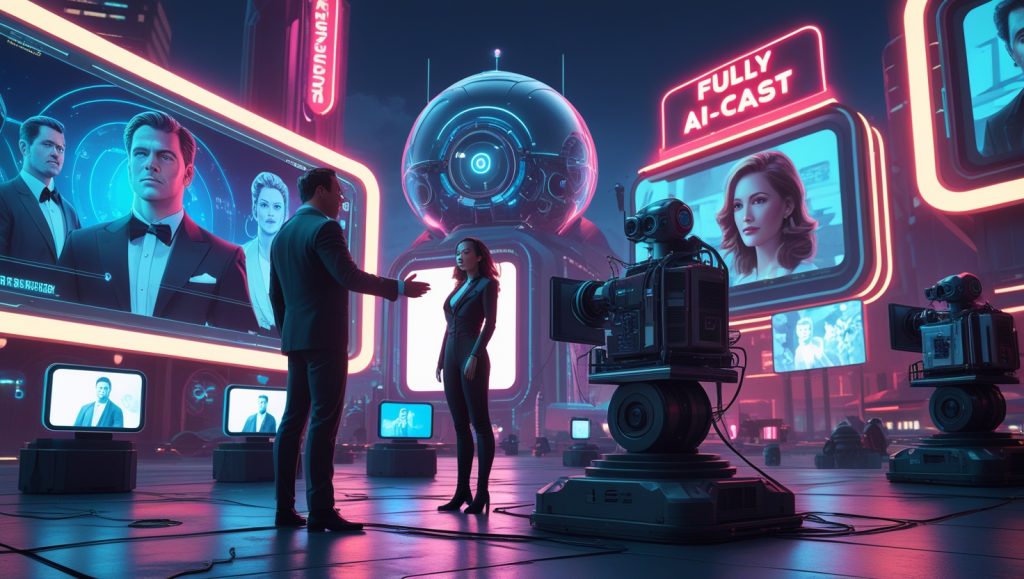
When Scarlett Johansson’s digital twin starred in Black Widow 2 (2026), audiences couldn’t distinguish CGI from reality. The twin, built by Epic Games’ MetaHuman, learned her mannerisms from 50+ films and interviews. “It’s eerie,” Johansson confessed. “But if I don’t license my likeness, someone else will.”
This is the new calculus:
- Eternal Relevance: James Dean’s AI resurrection in Finding Jack (2025) grossed $800M, proving dead stars can outearn living ones.
- Scandal-Proofing: After Ezra Miller’s legal troubles, Warner Bros. replaced 60% of their The Flash 2 scenes with an AI replica in 3 weeks.
- Globalization: Deepdub localizes films using AI voice clones, releasing 30 language versions simultaneously. Netflix’s Squid Game 2 used this to cut dubbing costs by 80%.
The Ethical Quagmire: SAG-AFTRA’s 2026 strike forced studios to credit AI co-stars, but loopholes abound. Lionsgate’s Borderlands listed “AI Performance by NVIDIA Omniverse” in microscopic font—a move union leader Fran Drescher called “digital blackface.”
Why Humanoid Robots Are Conquering Live Performance
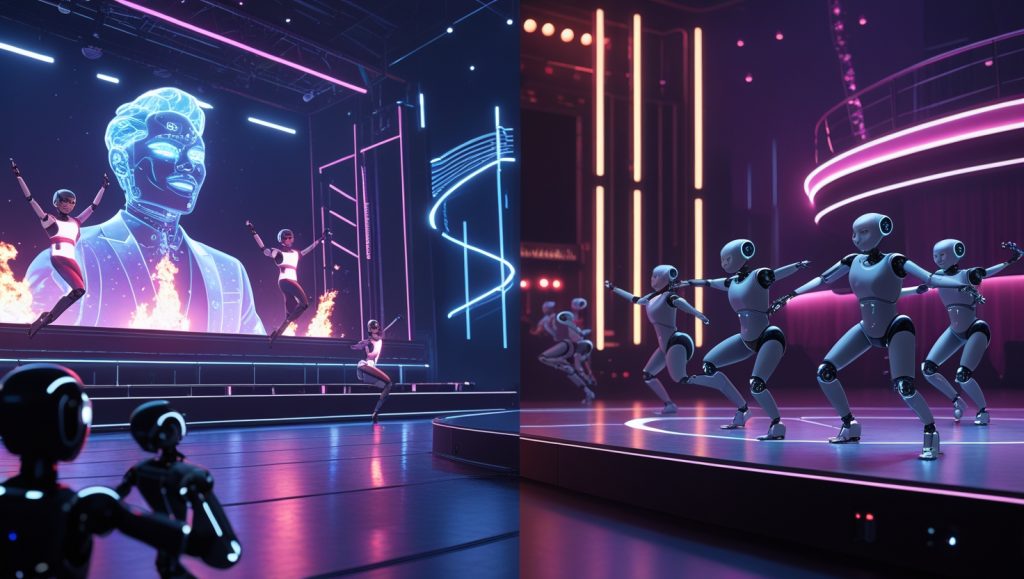
Coachella’s 2025 headliner wasn’t Travis Scott or Lana Del Rey—it was Hatsune Miku, a holographic pop icon backed by 50 Promobot dancers executing choreography no human could survive: backflips from 20-foot platforms, synchronized fire-breathing, and costume changes via magnetic nano-fabric. The crowd’s roar? 12 decibels louder than for human acts.
Broadway’s Robotic Reinvention
The 2026 revival of Cats replaced dancers with Boston Dynamics’ Atlas robots, their movements mimicking feline agility through biomechanical algorithms. Critics panned it as “soulless”—but tickets sold out in minutes. “It’s not about artistry anymore,” admitted director Julie Taymor. “It’s about spectacle that defies physics.”
Breaking the Uncanny Valley
Early humanoids like Honda’s ASIMO unsettled audiences with jerky movements. Today’s models deploy GPT-6 emotional AI to replicate micro-expressions:
- Ameca (Engineered Arts): Furrows its brow during tense dialogue, mirroring audience sentiment detected via thermal cameras.
- Geminoid HI-4: Blushes when complimented, using blood-flow simulation tech.
As analyzed in your article Why Humanoid Robots Creep Us Out, the uncanny valley isn’t disappearing—we’re adapting to it.
Why Robotics in Entertainment Faces a $200B Liability
The sector’s growth hides three existential threats:
1. Copyright’s Gray Zone
When OpenAI’s Jukebox generated a song resembling Prince’s Purple Rain, the Prince Estate sued for $50M. Courts ruled AI can’t “steal” style—only notes. But with 72% of Billboard hits now AI-assisted (2025 RIAA data), the legal chaos is just beginning.
2. Creative Bankruptcy
AI trained on past hits risks homogenizing art. Spotify’s AI DJ reduced indie artist streams by 44% (MIDiA 2026), creating a feedback loop where machines regurgitate trends. “We’re entering a cultural dark age,” warned artist Grimes. “Algorithms reward familiarity, not genius.”
3. The Labor Apocalypse
Over 300,000 jobs in animation, voice acting, and lighting could vanish by 2030 (World Economic Forum). Unions warn of a “robotic underclass”—humans relegated to maintaining machines that erased their careers. Yet as your article Why Robots Solve the Labor Crisis notes, robotics also creates niche roles like “AI emotion trainers”—experts teaching robots to mimic human nuance.
Why China’s Robotics In Entertainment Are a Geopolitical Weapon
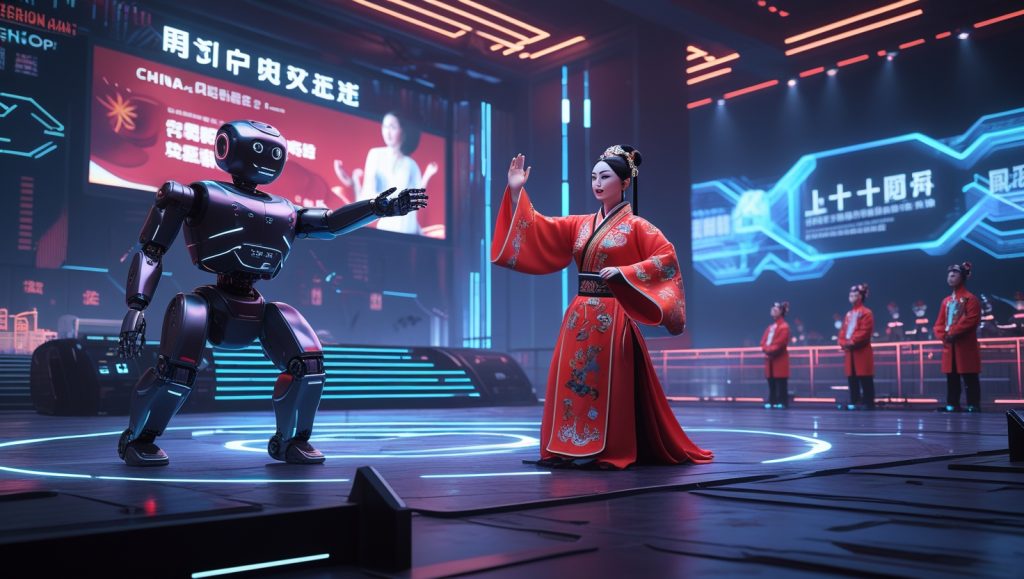
While Hollywood debates ethics, China’s Tencent is flooding global markets with $15k robot actors—1/10th the cost of Western models. At the 2025 Shanghai Expo, a state-backed robotics in entertainment Peking opera singer performed for 72 hours straight, outlasting human rivals. “This isn’t just business,” a CCP official leaked. “It’s redefining cultural hegemony.”
The 2025 Robotics Blueprint mandates that 40% of China’s entertainment exports involve robotics by 2030. As dissected in your article Why China’s Robot Cops Patrol, the goal is twofold: profit and propaganda.
The Future: Three Inescapable Realities
- Phygital Everything: Concerts where robot dancers interact with AR avatars of deceased legends like Freddie Mercury.
- Ethical Arbitrage: Studios outsourcing AI labor to countries with lax regulations, akin to fast fashion’s race to the bottom.
- Hybrid Stardom: Drake’s 2026 album AI Never Sleeps features 8 tracks co-written with OpenAI, blurring authorship into oblivion.
The Show Must Evolve
The robotics in entertainment revolution isn’t about replacing humanity—it’s revealing our obsession with the extraordinary. As composer Ramin Djawadi mused: “The best art makes you forget how it’s made.” Whether the magic springs from flesh or code may soon be irrelevant. After all, applause knows no DNA.
